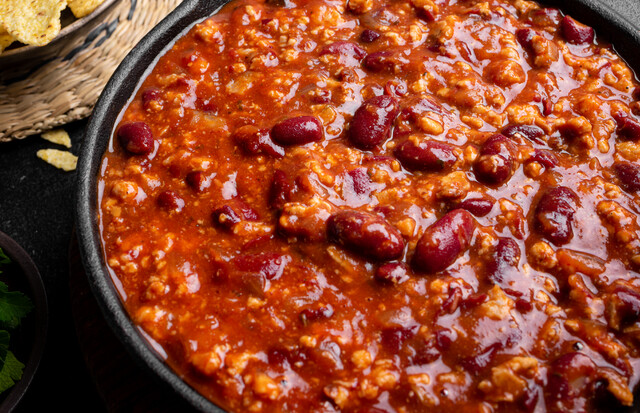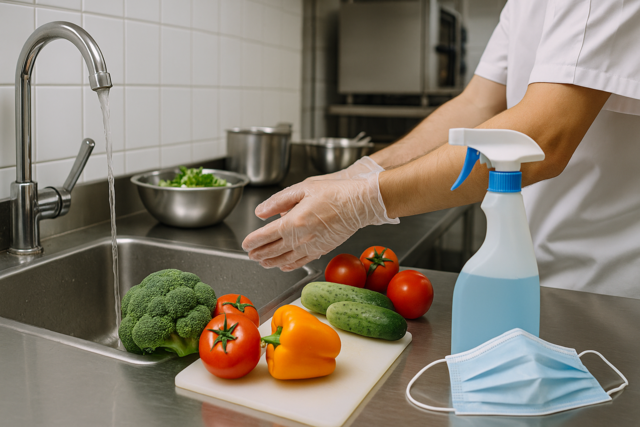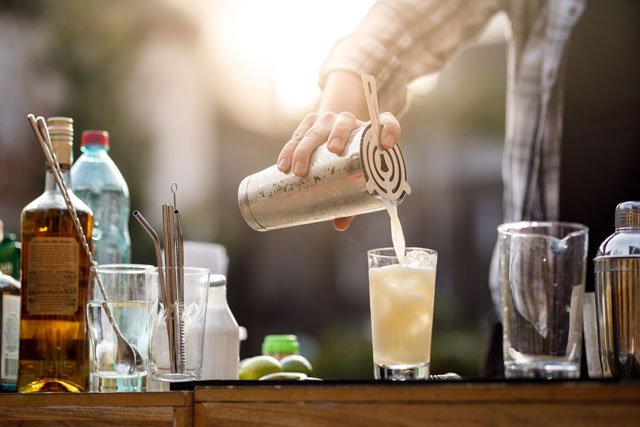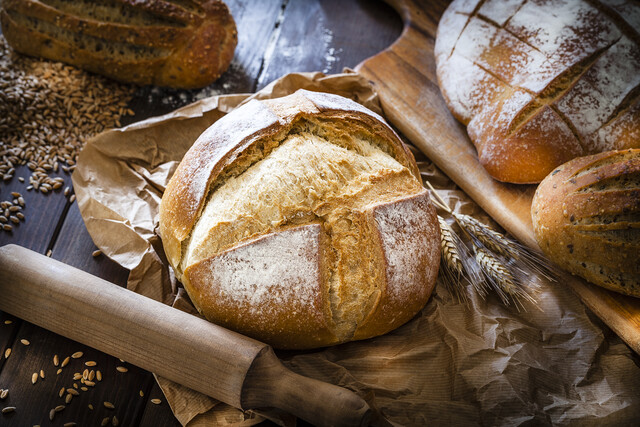Chez Nous is divided into three sections of staff members:
1)The Owners, or CEOs
2)The Front of the House (FOH), or dining room
3)The Back of the House (BOH), or kitchen
The owners, or CEOS, create the restaurant itself, or provide the money for its creation. They establish the theme of the restaurant and its decor, its rules and regulations, and overall system of operation. Ultimately, everyone working in the House is answerable to the CEOs. In larger chain restaurants, the CEOs may not even be visible to the staff, preferring to delegate authority to the House's general manager. In independent restaurants, the CEO may also act as the general manager, or its executive chef.
The Front of the House staff includes the general manager (who will also work closely with the Back of House staff), assistant manager(s), bar manager, and bartenders (if alcohol service is part of the restaurant), bar backs, hosts, wait staff, and bussers. Larger restaurants may have a sommelier (so-mel-yay) -- who acts as a wine specialist -- a headwaiter, a maitre d'hotel or maitre d' (may-truh-dee), who supervises the dining room, and the host staff.
Bartenders and Bar Backs (bar assistants/stockers) will function almost as an independent unit, although they will create drinks for the wait staff, and perhaps also serve food, if dining at the bar is permissible in your establishment.
Hosts, and/or the Maitre D', are the first to meet and greet your guests, so it is essential that these staff members are extremely positive, outgoing, and upbeat. They must ensure guests genuinely feel welcomed, not "processed." They must also systematically seat guests so their wait time is minimal, without overloading the servers.
The Back of the House staff includes the executive chef, or chef, sous chefs, line cooks, pantry cooks, prep cooks, and dishwashers. Most restaurants will also have a facilities manager (on-site technician for the physical plant of the restaurant), and janitors, who assist both Front and Back of House staff, when needed.
Line Cooks perform the bulk of all actual cooking. The "line" is a catch-all term for the grill, stoves, fryers, and pantries. Some line cooks may be specialized as grill cooks or saut� cooks, but a good chef will cross-train his line cooks to be able to handle multiple stations. The section of the line where cold food is prepared is called the pantry, or cold station. Pantry cooks, or "garde mangers" (guard mon-jay), work this station and use it to prepare salads, desserts, and cold appetizers or entr�es.
Prep Cooks prepare food for the line by thawing it, portioning it, chopping vegetables, and everything else that is needed for the line cooks to do their jobs.
Expediters, or "expos," work between the cooks and the Front of House staff. They ensure the quality of finished entr�es, arrange finished plates (or "covers"), and send them to the dining room. Food runners, or the wait staff, handle the actual delivery of covers.
The Front of House and the Back of House must function independently -- as well as with each other -- as parts of one seamless whole, for your restaurant to succeed. As its manager, you will often be the intermediary between the Front and Back of the House. You must ensure that both sides exist in a cooperative and not adversarial relationship. Respect, professional courtesy, and communication are paramount. For example, a server comes to the kitchen and shouts at the chefs for an order which is becoming late. The chefs have to stop what they're doing and look for her order, possibly shouting back at her, until a food runner returns to the kitchen to let the server know her order had already gone out. Now the server's ashamed, the chefs are irritated, and more orders may be late due to the interruption. Better communication would have made the entire scene unnecessary, but such situations unfortunately occur all the time.
A standing policy of having wait staff report to managers to inquire about long waits for meals will cut down on any friction between both sides of the House.
Your particular restaurant's owners will chiefly be concerned with the profitability of your unit, and they will make this your primary concern as well.This is as it should be, for without profit, you have no restaurant to manage.The profitability of restaurants can be very high, due to the price differential between foods and beverages purchased at wholesale and then prepared and served to the public at retail. Still, challenges abound in constant competition, bar and food cost controls, overhead, location, seasonal considerations, and the whims of your clientele.
Much of the profit potential of your restaurant can, and will, be influenced by you, its manager. Proper training can change unmotivated "order taker" waiters into savvy salesmen. Effective scheduling on your part can make the difference between losing guests due to an overlong wait when you're shorthanded, or losing money by having too many staff members standing around idle during slow periods. Creative sales contests that spur your sales staff to greater efforts may turn your typically "slow" season into a profitable one, perhaps one in which you earn a bonus for surpassing sales goals. A watchful eye on your expenses -- food and beverage purchasing, electricity, water, rent, waste management, taxes, and others -- will keep costs down and ensure more profit. Once you have mastered these, profits should increase as a matter of course.
Over and above profit, however, you as a manager must continually focus on safety --.both workplace safety and food safety. They're different things, but they're equally important. It does little good to sell a guest a $25 steak, only to receive a $250,000 lawsuit afterwards from an allergic reaction he received from one ingredient that the waiter forgot to mention. Meanwhile, in the kitchen, someone failing to observe proper food handling procedures could easily -- but unknowingly -- transmit a disease to a score of diners, making your restaurant "persona non grata" for any future diners.
Safety is a paramount and ongoing concern, but once you have established sufficient emergency protocols and adequately trained your staff, safety should become a matter of course, with all your staff members looking out for each other, and knowing what to do in any eventuality.
- Use proper plate-handling protocols to avoid spills or burns.
- Emphasize proper knife-handling techniques, and the use of cutting gloves. When carrying knives, they should be held straight down, against the outside of the leg.
- Always wear shoes with non-skid soles.
- Never run in the restaurant.
- Avoid backing up or making sudden, jerky movements.
- Use the correct doors in and out of the kitchen, and avoid sudden starts and stops; someone might be right behind you.
- Avoid horseplay and practical jokes.
- Report all injuries, no matter how slight, and get immediate first aid.
- Obey safety rules when working with any equipment, and report all defective equipment.
- Attend to spills and broken glass on the floor immediately -- warn others in the vicinity to avoid them while cleaning them up, or until they are cleaned up.
- If a guest has a handbag or personal object on the floor near the table, offer to move it so it won't be tripped on.
- Always store cleaning chemicals far away from any food products or serviceware.
As the manager, you should constantly remind all staff members of these rules, both verbally and with posted signage. Back of House employees are continually vulnerable to cuts and burns; Front of House employees are continually vulnerable to to slips and falls. Be ready to respond to all of these. You should also memorize the locations of fire exits, fire extinguishers, and first aid kits, and ensure that your staff members know their locations, as well. Post signage of the Heimlich maneuver and CPR to ensure that everyone has at least rudimentary knowledge of it.
Below are some considerations for each scenario.
ROBBERY: If you don't have them already, set up surveillance cameras focused on areas that have the most cash handling. Ensure your staff members know what to do in the event of a robbery. Proper cash handling techniques and timely "safe drops" can ensure that robberies only inflict minor economic damage. Neither you, nor anyone on your staff, should try to be a hero.
In the event of an armed robbery, comply with the robber's demands, while keeping as many guests and staff members out of harm's way. Remain as calm as possible, do not antagonize the robber(s). During the incident, seek to remember as many details as possible about the robber(s) -- their approximate height, weight, hair or eye color, clothing, accents, vehicle type (if used or seen) and/or license plate numbers. Call the police as soon as possible.
POWER FAILURES: You should already have a back-up manual ordering system in place so servers can still deliver checks -- if not, create one with small flashlights, calculators, lists of entree prices (with taxes included), and credit card carbons. You should also create a list of what foods and beverages can be prepared without power. During daylight hours, if there's adequate natural lighting available, your most major inconvenience might be a slower processing of orders, so you may wish to call a halt to seating new guests. (Inform waiting guests of the situation, of course.) Check local laws under fire codes to ensure it's legal to remain open if emergency exit signs won't come on. In the evening, distribute flashlights to as many staff members as possible. Ensure everyone remains calm.
FIRE: While great strides in fire prevention and fire safety have been made in the industry, restaurants still operate with fire constantly. With an eye on safety, restaurant fires are rare, but everyone should know what to do in the event of one. If a fire is small or if it is possible to extinguish it quickly with an extinguisher or water, then so much the better. In case of any fire that can't be extinguished right away, the area and/or the building should be evacuated and the fire alarm pulled. Call 9-1-1 immediately. Don't take chances, and don't let anyone back into the building until fire officials tell you it's safe to do so.
FLOODING: Depending on the severity, responses to this might range from merely sealing off the affected area, to shutting down the restaurant altogether. See if the restaurant sanitation has been compromised by the inflow of water. In the event flooding threatens the kitchen area, shut down all electrical appliances and gas equipment if you're able to, but evacuate any staff members, regardless.
STORMS: You'll want a radio or television somewhere within your restaurant to hear reports, although weather reports can also be had via a simple phone call. Keep abreast of weather reports to see how your restaurant might be affected and how. If driving conditions worsen to the point of becoming dangerous, you may wish to allow your staff members with the longest commutes to leave early, or remain at the location until the situation improves. During extreme weather conditions, it might be better to close down the restaurant altogether, although you may wish to allow those still present to remain in the building if going outside would endanger them.
In the case of a tornado, require everyone to stay away from the windows, and evacuate to the densest area of the restaurant that has the most solid walls; under extreme conditions, walk-in coolers or storerooms may have the strongest construction.
In the case of an earthquake, turn off any gas appliances. Contrary to popular belief, nobody should take shelter from falling debris underneath a table. Rescue workers have confirmed that people attempting to take shelter from falling debris underneath objects are often crushed by the object itself when it collapses. However, lying closely adjacent to a sturdy object instead of underneath it creates a 'zone of safety' where falling debris may crush the object but leave a safe area of space around it.
During any emergency, always think safety first. When the danger is over, the situation will become that of checking up on personnel, recording any damage to the facility or supplies for the owners and insurers, and most importantly, guest recovery. Guest recovery will be covered more in depth in an upcoming chapter.
To ensure profitability, you must maximize revenue by offering the best dining experience possible at a competitive rate, while minimizing costs wherever possible. Often, in a larger corporate or chain environment, you may not have the wherewithal to set prices or change the menu. In such cases, profitability is still not necessarily out of your hands altogether. You may -- and should -- set sales contests for servers, giving awards for the top sales of specific items -- free movie tickets for the top sellers of your best dessert, for example. One restaurant awards employees for selling "the perfect check," which is an alcoholic beverage, an appetizer, an entr�e, and a dessert for each guest at a particular table.
You should also train and re-train your wait staff to suggestively sell items -- "Are you ready to order" is poor salesmanship compared to, "May I start you off you one of our famous Mai Tais, and some Nachos for an appetizer?" (However, some guests will prefer order-takers to overzealous salespeople; servers should be able to use either method as the situation requires.)
Within your abilities, seek to augment sales by creating unique "signature dishes" that guests can't receive elsewhere, and mention them in your advertising media (although word of mouth will ultimately do most of the selling for you). You can also reach out to area demographics (specials for local high school students, veterans, or business owners or employees) and offering specials on holidays -- or even inventing holidays ("Sunday means SUNDAE at Chez Nous!"). You may also wish institute a "frequent diner" program to reward repeat customers with priority seating and/or complimentary desserts, appetizers or other bonuses. In-house flyers, signage, and even buttons on uniforms can remind or encourage guests to order special items. Coupons, on the other hand, may spur sales temporarily, but statistics reveal that users of coupons tend to only visit restaurants due to the savings of the coupon itself, and rarely return to pay full price.
























